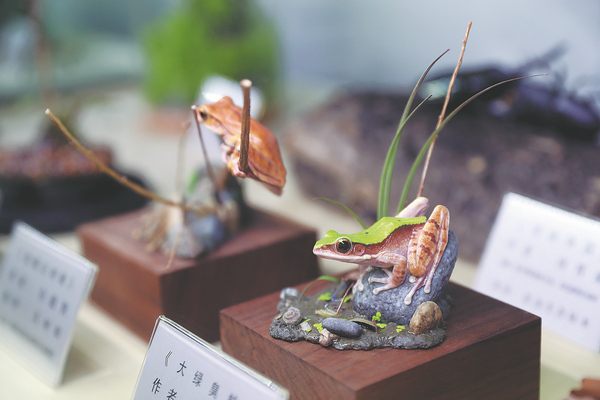

In dynamic scenes that show them in their natural habitats, the once-living creatures are still remarkably lifelike thanks to the skilled hands of their taxidermists.
For Shan Shaojie, who is in charge of the museum's science popularization activities, there is a story behind every piece on display.
"The kingfisher piece caught my eye at first sight. It does more than capture the stunning moment when the little bird catches a fish from the water, making a large splash," Shan says, adding that taxidermist who created the tableau, Xiao Yongyi, positioned every feather on the bird's wings and even added fake droplets of water to them.
In another corner, another tableau by Xiao — this time a female emu incubating eggs in a nest — has been creatively designed to hide the fact that one of the emu's legs was missing when the taxidermist got the body.
Shan says this shows that a skilled taxidermist must have experience in many different areas, not just knowledge of how to preserve dead animals and insects, but also an understanding of the animals and their habitats, of art, and even of zoology.
The 400-odd entries are divided into 10 subcategories as specific as large animals with a body length of more than 70 centimeters, medium- and small-sized animals with a body length over 50 cm, plasticized specimens, sculptures and creative items.
Shan says that besides traditional methods such as taxidermy — a form of preservation in which an animal's tanned skin is placed over a sculpted model — the competition also covers stimulated and plasticized specimens.
"To protect endangered animals, we have several red-crowned crane specimens that use the feathers from a white goose," he says.
In the sculpted model category, he mentions that three frogs have won the first prize.
"Thanks to advances in sculpture techniques, the frogs amazed all the judges. Although they are fake, they are perfect replicas, and seem so real and alive," he adds.
As the first generation of taxidermists were trained in China in the 1860s, the country is a relative late comer to the practice. To help practitioners improve their skills, the biennial China Taxidermy Championships was launched by the Institute of Zoology of the Chinese Academy of Sciences, the China Zoological Society, and the International Society of Zoological Sciences in 2012.
After seeing the exhibition, Yucheng knows exactly what he wants to do in life. "When I grow up, this is where I will work," he says pointing at the museum's front gate.
wangqian@chinadaily.com.cn